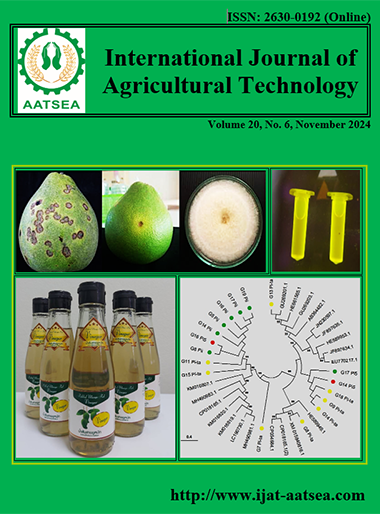The screening of soybean drought tolerant using polyethylene glycol 6000 at Entisol of Bengkulu Coastal Land
Main Article Content
Abstract
The result showed that tested four soybean varieties (Anjasmoro, Dering 1, Devatra 2 and Grobogan) and the concentrations of PEG 6000 (0% control, 5% 10 %, 15% and 20%) did not interact in affecting the number of flowers and the number of pods. Soybean varieties varied in their tolerance to drought stress at Entisol. Based on all observed both vegetative and generative growth variables, the order of drought tolerance of soybean varieties (from the most to the least tolerant) were Anjasmoro, Dering 1, Devatra 2, and Grobogan. Increasing the concentration of PEG 6000 to the highest one of 20%, constantly reduced the vegetative and generative growths (plant height, number of leaves, number of flowers and number of soybeans pods). The predicted effective dose selection of PEG 6000 for soybean drought tolerant was 19.50%; it reduced yields up to 50%.
Article Details

This work is licensed under a Creative Commons Attribution-NonCommercial-NoDerivatives 4.0 International License.
References
Agrios, G. N. (1988). Plant Pathology, 3rd eds Academic Press, New York.
Anaytullah., Intjar, A. and Kumar, P. V. (2008). Effect of water potential treatment on seed germination and seedlings growth of some rice cultivars (Oryza sativa L.). Indian Journal of Agriculture Research, 42:57-61.
Ange, U. M., Srividhya, S., Vijayalakshmi, C. and Boominathan, P. (2016). Temperature induction response reveals intrinsic thermo tolerant genotypes in soybean. Legume Research, 39:926-930.
Bapeda Provinsi Bengkulu (2017). Rencana Aksi Daerah Pengembangan Ekonomi Kemaritiman Provinsi Bengkulu tahun 2017. http://bappeda.bengkuluprov.go.id/wp-content/uploads/2018/ RAD%20Kemaritiman.pdf. diunduh tanggal 10 April 2020.
Balai Penelitian Tanaman Aneka Kacang dan Umbi (2018). Gelar Teknologi Budidaya Kedelai di Lahan Kering Beriklim Kering. http://balitkabi.litbang.pertanian.go.id/berita/gelar-teknologi-budidaya-kedelai-dilahan-kering-beriklim-kering/ diakses tanggal 1 Oktober 2018
Bertham, Y. H., Arifin, Z. and Nusantara, A. D. (2019). The improvement of yield and quality of soybeans in a coastal area using low input technology based on biofertilizers. International Journal on Advanced Science, Engineering and Information Technology, 9:787-791.
Bertham, Y. H., Dipo Nusantara, A. and Pujiwati, H. (2020). Selection of soybean varieties for coastal zones in Bengkulu. International Journal on Advanced Science, Engineering and Information Technology, 10:2152-2157.
Blum, A. (2009). Effective use of water (EUW) and not water-use efficiency (WUE) is the target of crop yield improvement under drought stress. Field Crops Research, 112:119-123.
Burton, A. L., Lynch, J. P. and Brown, K. M. (2013). Spatial distribution and phenotypic variation in root cortical aerenchyma of maize (Zea mays L.). Plant Soil, 367:263-274.
Fang, Y. and Xiong, L. (2015). General mechanisms of drought response and their application in drought resistance improvement in plants. Cellular and Molecular Life Sciences, 72:673-689.
Fletcher, A.L., Sinclair, T. R. and Allen, L. H. (2007). Transpiration responses to vapour pressure deficit in well-watered ‘slow-wilting’ and commercial soybean. Environmental and Experimental Botany, 61:145-151.
Fleury, D., Jefferies, S., Kuchel, H. and Langridge, P. (2010). Genetic and genomic tools to improve drought tolerance in wheat. Journal of Experimental Botany, 61:3211-3222.
Hamayun, M. S., Khan, A., Shinwari, Z. K., Khan, A. L., Ahmad N. and Lee, I. J. (2010). Effect of polyethylene glycol induced drought stress on physio-hormonal attributes of soybean. Pakistan Journal of Botany, 42:977-986.
Herawati, R., Purwoko, B. S., Dewi, I. S., Romeida, A., Ganefianti, D. W. and Marlin (2020). Analysis of polyethylene glycol (PEG) and proline to evaluate drought stress of double haploid new type upland rice lines. International Journal of Agricultural Technology, 16:785-798.
Meister, R., Rajani, M. S., Ruzicka, D. and Schachtman, D. P. (2014). Challenges of modifying root traits in crops for agriculture. Trends in Plant Science, 19:779-788.
Mexal, J., Fisher J. T., Osteryoung, J. and Patrick Reid C. P. (1975). Oxygen availability in polyethylene glycol solutions and its implications in plant-water relations. Plant Physiology, 55:20-24.
Mir, R. R., Zaman-Allah, M., Sreenivasulum N., Trethowan, R. and Varshney, R. K. (2012). Integrated genomics, physiology and breeding approaches for improving drought tolerance in crops. Theory and Applied Genetics, 125:625-645.
Ries, L. L., Purcell, L. C., Carter, T. E., Jr Edward, J. T. and Kin, C. A. (2012). Physiological traits contributing to differential canopy wilting in soybean under drought. Crop Science, 52:272-281.
Salazar-Henao, J. E., Vélez-Bermúdez, I. C. and Schmidt, W. (2016). The regulation and plasticity of root hair patterning and morphogenesis. Development, 143:1848-1858.
Tanaka, Y., Fujii, K. and Shiraiwa, T. (2010). Variability of leaf morphology and stomatal conductance in soybean (Glycine max (L.) Merr.] cultivars. Crop Science, 50:2525-2532.
Valliyodan, B, Ye, H., Song, L., Murphy, M., Shannon, J. G. and Nguyen, H. T. (2017). Genetic diversity and genomic strategies for improving drought and waterlogging tolerance in soybeans. Journal of Experimental Botany, 68:1835-1849.
Vijay, L. R., Ravichandran, V. and Boominathan, P. (2018). Assessment of soybean genotypes for PEG induced drought tolerance at germination and seedling. Madras Agriculture Journal, 105:1-6.
Widoretno, W. (2011). Skrining untuk toleransi terhadap stres kekeringan pada 36 varietas kedelai pada fase perkecambahan. Berkala Penelitian Hayati, 16:133-142.


